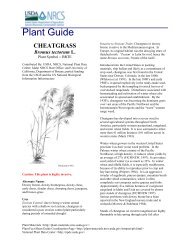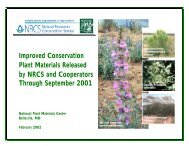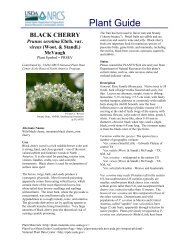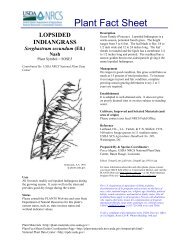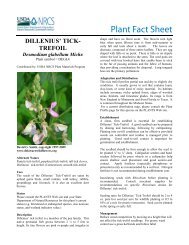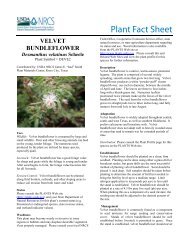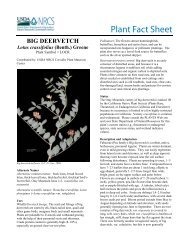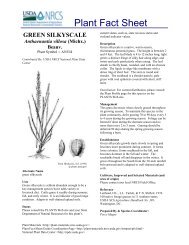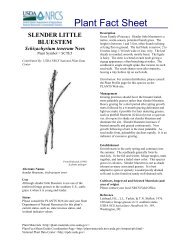Common Wooly Sunflower Plant Guide - USDA Plants Database
Common Wooly Sunflower Plant Guide - USDA Plants Database
Common Wooly Sunflower Plant Guide - USDA Plants Database
You also want an ePaper? Increase the reach of your titles
YUMPU automatically turns print PDFs into web optimized ePapers that Google loves.
COMMON WOOLLY<br />
SUNFLOWER<br />
Eriophyllum lanatum (Pursh)<br />
Forbes<br />
<strong>Plant</strong> Symbol = ERLA6<br />
Contributed by: NRCS <strong>Plant</strong> Materials Center,<br />
Pullman, WA<br />
Eriophyllum lanatum. Ben Legler, University of<br />
Washington Burke Herbarium<br />
Alternate Names<br />
Oregon sunshine, golden yarrow, yarrow leaved<br />
eriophyllum, dwarf woolly sunflower, Pursh’s<br />
woolyleaf<br />
Uses<br />
Pollinator habitat: Eriophyllum lanatam attracts<br />
beetles, syrphid flies, bees, moths and butterflies<br />
(Mooring 1975). Butterflies that are known to visit<br />
this plant include: orange sulfur, red admiral,<br />
comma, and skipper (Lady Bird Johnson Wildflower<br />
Center 2011). An endangered butterfly in Oregon,<br />
<strong>Plant</strong> <strong>Guide</strong><br />
Fender’s Blue (Icaricia icarioides fenderi) relies on<br />
E. lanatum for a source of nectar (Schultz 2001).<br />
Ornamental: This plant is hardy to Zone 3 and can<br />
be used in perennial borders, along pathways, and in<br />
rock gardens and embankments (Rugged Country<br />
<strong>Plant</strong>s 2011). The Lady Bird Wildflower Center<br />
(2011) recommends selecting a local ecotype,<br />
planting several plants in a group, and pruning the<br />
dead branches.<br />
Rangeland vegetation: This plant is quick to<br />
establish and can be used for revegetation and<br />
diversification of rangeland in a variety of habitats.<br />
Ethnobotanical: People of the Miwok tribe made a<br />
poultice of the leaves of this plant and bound them to<br />
aching parts of the body; the Skagit rubbed the leaves<br />
on skin to prevent chapping; and the Chehalis used<br />
the dried flowers as a love charm (Native American<br />
Ethnobotany <strong>Database</strong> 2011).<br />
Status<br />
Please consult the PLANTS Web site and your State<br />
Department of Natural Resources for this plant’s<br />
current status (e.g., threatened or endangered species,<br />
state noxious status, and wetland indicator values).<br />
Description<br />
General: <strong>Sunflower</strong> family (Asteraceae).<br />
Eriophyllum lanatum is a native forb or subshrub,<br />
and may be an annual, biennial, or short- or longlived<br />
perennial depending on site conditions. It has a<br />
multi-branched, erect to spreading form and grows to<br />
10 to 60 cm (4 to 24 in) tall. Stems and leaves are<br />
covered with white hairs. Leaves are 2.5 to 7.5 cm (1<br />
to 3 in) long and irregularly divided into narrow<br />
lobes. Flowers are solitary, on long peduncles and<br />
bloom May through July. The flower head is 4 to 6.5<br />
cm (1.5 to 2.5 in) wide with golden yellow disk<br />
flowers and 8 to 12 yellow ray flowers, each 1.5 to 2<br />
cm (0.6 to 0.8 in) long. Flower bracts are broad,<br />
erect and keeled. Seed is narrow, smooth, has four<br />
angles and a crown of scales or short pappus. (Burke<br />
Museum of Natural History and Culture 2011;<br />
Hitchcock and Cronquist 1973; Knopf 2001; Lady<br />
Bird Johnson Wildflower Center 2011; Mooring<br />
2001).<br />
This plant was first collected by Lewis and Clark<br />
along the Clearwater River near Kamiah, Idaho, on<br />
June 6, 1806 (Lewis and Clark Herbarium 2011). It<br />
was named Actinella lanata by Pursh and renamed<br />
Eriophyllum lanatum by Forbes. The genus name
Eriophyllum is from Greek “erion” which means<br />
wool and “phyllon” which means leaf. The species<br />
name lanatum translated from Latin is “covered with<br />
long woolly hair” (Charters 2011).<br />
Distribution: Eriophyllum lanatum is common on<br />
both sides of the Cascade Mountains from British<br />
Columbia south to Washington, Oregon and<br />
California. Its range extends east to Nevada, Idaho,<br />
northwestern Utah, western Wyoming, and western<br />
Montana. The species is currently divided into 12<br />
varieties, and among and within varieties there is a<br />
great deal of genetic and phenotypic variation<br />
(Mooring 1975).<br />
A factor contributing to the variation is the presence<br />
of polyploids. Mooring (1975) found the<br />
Eriophyllum lanatum complex contains diploid,<br />
tetraploid, hexaploid and octoploid populations.<br />
Diploid populations occupy the geographical and<br />
environmental extremes of the complex, and<br />
polyploid populations occur where the ranges of the<br />
varieties overlap (Mooring 2001). Polyploidy has<br />
enabled intervarietal hybridization, and many<br />
polyploids are intermediate populations that cannot<br />
be assigned to one particular variety. California is<br />
the geographic center of Eriophyllum lanatum, with<br />
the largest amount of genetic diversity, and where 10<br />
out of the 12 varieties occur (Mooring 2001). For<br />
current distribution of this species, please consult the<br />
<strong>Plant</strong> Profile page on the PLANTS Web site.<br />
Habitat: This plant is often found growing in rocky<br />
areas along roadsides throughout its range. It is also<br />
found on coulees, bluffs, and canyons, and in dry<br />
grassland, thickets and forests (Knopf 2001; Lyons<br />
and Merilees 1995).<br />
Adaptation<br />
Eriophyllum lanatum is adapted to areas with dry,<br />
rocky or sandy soil which receive a minimum of 25<br />
cm (10 in) annual precipitation at elevations from sea<br />
level to 3,050 m (10,000ft). The plant has a high<br />
drought tolerance due to its white hairs that conserve<br />
water by reflecting heat and reducing air movement<br />
across the leaf surfaces (Knopf 2001).<br />
Establishment<br />
<strong>Plant</strong>s can be established by seed or seedlings. Seeds<br />
should be drilled into a weed-free seed bed in the fall<br />
at a rate of 3.4 kg PLS per ha (3 lbs PLS per acre)<br />
and at a depth of 0.6 to 1.25 cm (0.25 to 0.5 in).<br />
When planted in a mix, the seeding rate should be<br />
adjusted according to the proportion of the mix. The<br />
seed requires a cold and moist period of about 90<br />
days for optimal germination (Skinner 2007).<br />
To transplant seedlings, the seed should be planted in<br />
containers in October or November, stratified in cold<br />
and moist conditions for a period of 90 days, and<br />
moved inside to a greenhouse. The plants should be<br />
hardened off in a cold frame for 2 to 4 weeks prior to<br />
transplanting to a prepared field site (Skinner 2007).<br />
<strong>Plant</strong>s should be spaced 15 to 45 cm (6 to 18 in) apart<br />
(Rugged Country <strong>Plant</strong>s 2011).<br />
Management<br />
Eriophyllum lanatum is a prolific seed producer and<br />
will rapidly spread to any surrounding open ground.<br />
If plant spread is not desired, flower heads should be<br />
removed prior to seed ripening.<br />
The Forest Service J. Herbert Stone Nursery in<br />
Medford, OR, reports the biggest challenge to<br />
production of E. lanatum seed is weed control. They<br />
employ a variety of weed control techniques,<br />
including fumigating the soil prior to planting,<br />
cultivation, mowing, herbicides and hand weeding<br />
(Archibald 2006).<br />
Pests and Potential Problems<br />
Insects may significantly damage the foliage and seed<br />
(Mooring 2001).<br />
Environmental Concerns<br />
None.<br />
Eriophyllum lanatum seeds. Bend Seed Extractory,<br />
Seeds of Success<br />
Seeds and <strong>Plant</strong> Production<br />
E.lanatum is self-incompatible and therefore requires<br />
an insect or other vector for pollination (Mooring<br />
1975). Cane (2011b) has discovered<br />
E. lanatum is visited and pollinated by the cavitynesting<br />
solitary bees Osmia montanum and O.<br />
californica. These species are readily managed in<br />
standard nesting substrates for Osmia bees, and have<br />
been studied for decades, most recently as pollinators<br />
of balsamroot. (Cane 2005, Cane 2011a).<br />
Most Eriophyllum lanatum plants will flower and<br />
produce seed in their first year of growth. Seeds<br />
ripen in July, but ripening date may vary depending<br />
on elevation. The seed pappus is reduced to short
scales, therefore the seed is not wind-borne. Seed is<br />
retained on the flower head longer than many other<br />
Asteraceae species but will shatter within a week<br />
after ripening (Skinner 2007). A brush machine or<br />
hammer mill can be used to process the seed prior to<br />
cleaning with air screen equipment (Skinner 2007;<br />
Barner 2009). A gravity table may also be used to<br />
remove the remaining unfilled seed and inert<br />
material (Barner 2009). There are about 1,782,000<br />
seeds per kg (810,000 seeds per lb) (Lambert 2005).<br />
Experiments at the Pullman <strong>Plant</strong> Materials Center<br />
demonstrated an extended cold moist stratification<br />
period is needed to break seed dormancy. Skinner<br />
(2007) had 0% germination with no stratification,<br />
10% germination with 45 days stratification, and<br />
75% germination with 90 days stratification. Seed<br />
stratified longer than 90 days in the fluctuating spring<br />
temperatures achieved 82% germination. Some seed<br />
germinated during stratification, indicating<br />
germination will occur at low temperatures. Seed<br />
stored for 1 year in controlled conditions (5C and<br />
40% humidity) and sown without pretreatment failed<br />
to emerge (Skinner 2007). Mooring (2001) found<br />
seed viability decreased rapidly after 2 years of<br />
storage at room temperature, but some seed remained<br />
viable after 8 years.<br />
To produce seed of Eriophyllum lanatum, the Forest<br />
Service J. Herbert Stone Nursery sows seedbeds in<br />
the fall at a rate necessary to achieve 130 plants per<br />
square meter (12 plants per square foot) (Archibald<br />
2006). The seed is sown in bands 1.9 cm (0.75 in)<br />
deep, 3 cm (1.25 in) wide and 30 cm (12 in) apart<br />
with a modified Love/Oyjord® drill. Packing wheels<br />
are used to press the seed into the soil, and the seed is<br />
covered with 6 to 8 mm (0.25 to 0.33 in) of sawdust<br />
which is kept moist with irrigation until fall rains<br />
begin. Seed is harvested the following summer with<br />
a small plot combine, and the remaining plant residue<br />
is removed with a silage chopper. Seed yields have<br />
varied considerably depending on seedlot, growing<br />
season and age of the crop. A plot is typically<br />
harvested for a maximum of 5 years (Archibald<br />
2006).<br />
Cultivars, Improved, and Selected Materials (and<br />
area of origin)<br />
None, although seed and seedlings are available from<br />
several vendors.<br />
References<br />
Archibald, C. 2006. Seed production protocols for<br />
Anaphalis margaritacea, Eriophyllum lanataum<br />
and Eriogonum umbellatum. Native <strong>Plant</strong>s J.<br />
7:47-51.<br />
Barner, J. 2009. Propagation protocol for production<br />
of Eriophyllum lanatum (Pursh) Forbes seeds;<br />
<strong>USDA</strong> FS - R6 Bend Seed Extractory, Bend,<br />
OR. In: Native <strong>Plant</strong> Network. [Online]<br />
Available at: http://www.nativeplantnetwork.org<br />
(accessed 27 Jan 2011). University of Idaho,<br />
College of Natural Resources, Forest Research<br />
Nursery, Moscow, ID<br />
Burke Museum of Natural History and Culture.<br />
[Online]. Available at:<br />
http://biology.burke.washington.edu/herbarium/i<br />
magecollection.php (accessed 27 Jan 2010).<br />
University of Washington, Seattle, WA.<br />
Cane, J.H. 2005. Pollination needs of arrowleaf<br />
balsamroot, Balsamorhiza sagittata<br />
(Heliantheae: Asteraceae). Western North<br />
American Naturalist 65 (3): 359-364.<br />
Cane, J.H. 2011a. Specialist Osmia bees forage<br />
indiscriminately among hybridizing<br />
Balsamorhiza floral hosts.<br />
Oecologia (in press).<br />
Cane, J.H. 2011b. Personal communication.<br />
Charters, M.L. 2011. California <strong>Plant</strong> Names: Latin<br />
and Greek Meanings and Derivations. [Online]<br />
Available at:<br />
http://www.calflora.net/botanicalnames/<br />
(accessed 27 Jan 2011).<br />
Hitchcock, C.L. and A. Cronquist. 1973. Flora of the<br />
Pacific Northwest. University of Washington<br />
Press, Seattle and London.<br />
Knopf, A. A. 2001. National Audubon Society Field<br />
<strong>Guide</strong> to Wildflowers, Western Region.<br />
Chanticleer Press, New York, NY.<br />
Lady Bird Johnson Wildflower Center. 2011.<br />
[Online] Available at:<br />
http://www.wildflower.org/plants/result.php?id_<br />
plant=ERLA6 (Accessed 27 Jan 2011). Austin,<br />
TX.<br />
Lambert, S. 2005. <strong>Guide</strong>book to the Seeds of Native<br />
and Non-Native Grasses, Forbs and Shrubs of<br />
the Great Basin. Idaho BLM Technical Bulletin<br />
2005-04. USDI-BLM, Boise, ID.<br />
Lewis and Clark Herbarium. 2011. [Online]<br />
Available at:<br />
http://www.plantsystematics.org/reveal/pbio/Ln<br />
C/LnCpublic4.html (Accessed 27 Jan 2011).<br />
Cornell University, Ithaca, NY, and University<br />
of Maryland, College Park, MD.<br />
Lyons, C.P. and B. Merilees. 1995. Trees, Shrubs and<br />
Flowers to Know in Washington and British<br />
Columbia. Lone Pine Press, Auburn, WA,<br />
Vancouver, BC, and Edmonton, AB.<br />
Mooring, J.S. 1975. A cytogeographic study of<br />
Eriophyllum lanatum (Compositae, Helenieae).<br />
Amer. J. Bot. 62(10):1027-1037.<br />
Mooring, J.S. 2001. Barriers to interbreeding in the<br />
Eriophyllum lanatum (Asteraceae, Helenieae)<br />
species complex. Amer. J. Bot. 88(2):285-312.<br />
Native American Ethnobotany <strong>Database</strong>. 2011.<br />
[Online] Available at http://herb.umd.umich.edu/<br />
(Accessed 27 Jan 2011). University of Michigan,<br />
Dearborn, MI.
Rugged Country <strong>Plant</strong>s. 2011. [Online] Available at:<br />
http://www.ruggedcountryplants.com/eriophyllu<br />
m-lanatum.htm (Accessed 27 Jan 2011).<br />
Schultz, C.B. 2001. Restoring resources for an<br />
endangered butterfly. J. of Appl. Eco. 38:1007-<br />
1019.<br />
Skinner, D. 2007. Propagation protocol for<br />
production of container Eriophyllum lanatum<br />
(Pursh) Forbes plants (10 cu in). <strong>USDA</strong>-NRCS<br />
Pullman <strong>Plant</strong> Materials Center, Pullman, WA.<br />
In: Native <strong>Plant</strong> Network [Online] Available at:<br />
http://www.nativeplantnetwork.org (Accessed 27<br />
Jan 2011) University of Idaho, College of<br />
Natural Resources, Forest Research Nursery,<br />
Moscow, ID.<br />
Prepared By<br />
Pamela L.S. Pavek, <strong>USDA</strong> NRCS <strong>Plant</strong> Materials<br />
Center, Pullman, Washington<br />
Citation<br />
Pavek, P.L.S. 2011. <strong>Plant</strong> guide for common woolly<br />
sunflower (Eriophyllum lanatum). <strong>USDA</strong>-Natural<br />
Resources Conservation Service, Pullman <strong>Plant</strong><br />
Materials Center. Pullman, WA.<br />
Published: March 2011<br />
Edited: 08Mar11 jab; 15Mar11 plsp<br />
For more information about this and other plants,<br />
please contact your local NRCS field office or<br />
Conservation District at http://www.nrcs.usda.gov/<br />
and visit the PLANTS Web site at<br />
http://plants.usda.gov/ or the <strong>Plant</strong> Materials Program<br />
Web site http://plant-materials.nrcs.usda.gov.<br />
PLANTS is not responsible for the content or<br />
availability of other Web sites.<br />
<strong>USDA</strong> IS AN EQUAL OPPORTUNITY PROVIDER AND EMPLOYER



